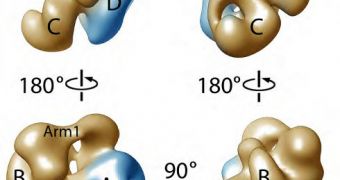A group of investigators at the US Department of Energy's (DOE) Lawrence Berkeley National Laboratory (Berkeley Lab) announces the development of a 3D model representing a protein complex that is critical to the development of the human fetus.
This is the first time that such a detailed and complete picture of this complex is produced. The protein is responsible for producing both birth defects and certain forms of cancer, and has been a target for analysis for quite some time.
New and improved therapeutic drugs could soon emerge based on the new research, the team says. Learning more about the architecture of the Polycomb Repressive Complex 2 (PRC2) molecule will enable researchers to find new targets for treatment.
The investigation was led by Berkeley Lab electron microscopy expert and biophysicist Eva Nogales. She also holds appointments with the University of California in Berkeley (UCB), and the Howard Hughes Medical Institute (HHMI).
“We present a complete molecular organization of human PRC2 that offers an invaluable structural context for understanding all of the previous biochemical and functional data that has been collected on this complex,” the team leader says.
“Our model should also be an invaluable tool for the design of new experiments aimed at asking detailed questions about the mechanisms that enable PRC2 to function and how those mechanisms might be exploited,” she adds.
Together with former Berkeley Lab postdoctoral fellow Claudio Ciferri, Nogales was the corresponding author of a new paper detailing the findings, entitled “Molecular Architecture of Human Polycomb Repressive Complex 2,” which appears in the latest issue of the esteemed journal eLife.
“PRC2 controls stem cell differentiation by regulating the expression of specific genes through the binding and methylation of histones, the proteins in chromatin that help bundle DNA into nucleosomes,” Nogales goes on to say.
This is primarily why PRC2 has been put under such scrutiny by pharmaceutical companies over the years. Researchers believe that uncovering its secrets could lead to the development of advanced treatments for a variety of diseases, the likes of which are currently unavailable.
Funds for the new study were provided by the National Institute of General Medical Sciences, the Howard Hughes Medical Institute and the European Union Seventh Framework Program PROSPECTS.

 14 DAY TRIAL //
14 DAY TRIAL //